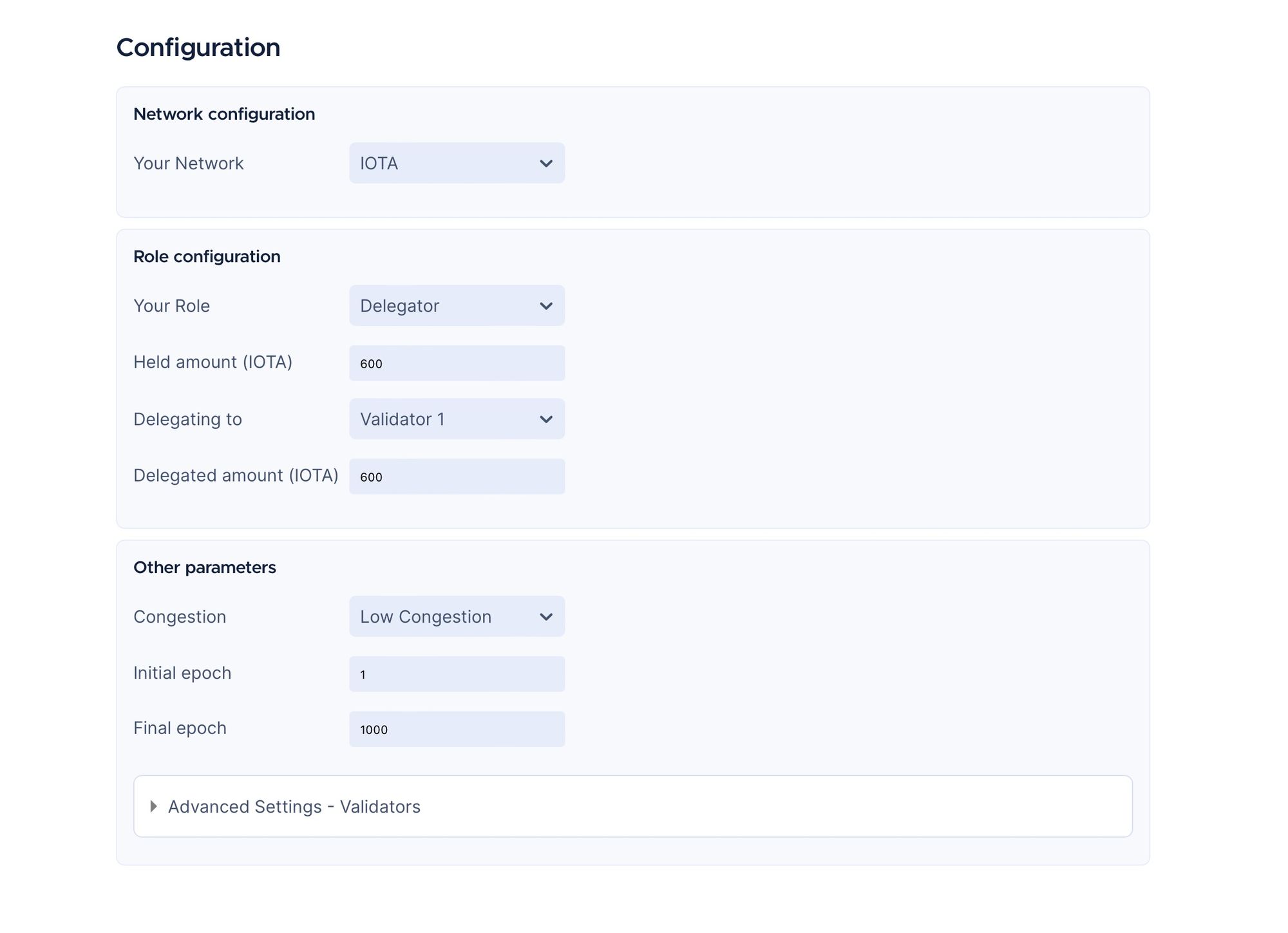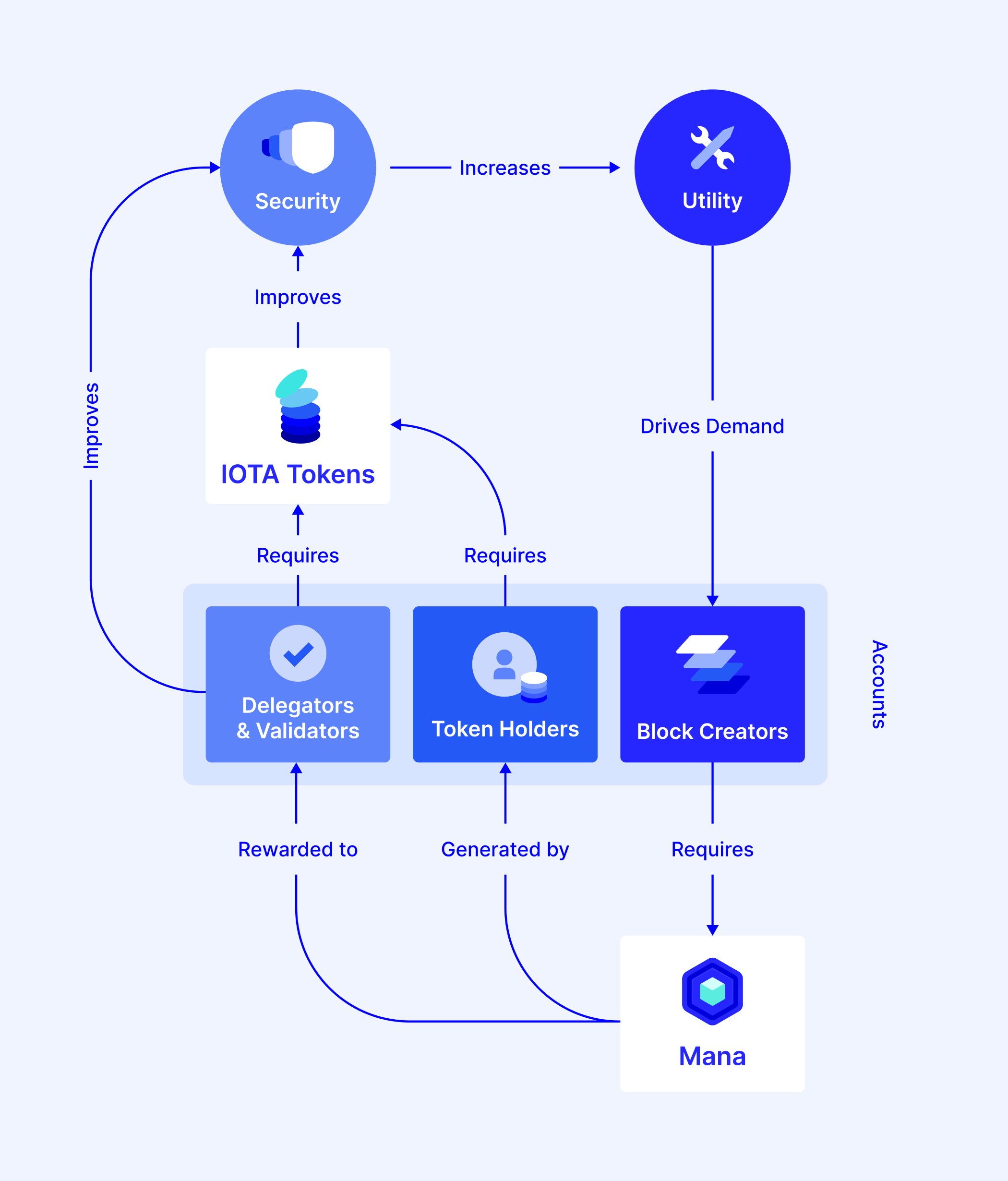IOTA 2.0 Introduction Part 13
TL;DR:
IOTA 2.0’s sustainable Mana-based tokenomics will establish a circular, replenishable economy. Instead of wealth flowing in one direction from the system’s users to its maintainers, all IOTA token holders receive Mana with which they can access the network. Validators and delegators are incentivized with additional Mana that can be used or sold, while everyone has the same opportunities to participate in the network.
Having introduced the key elements of IOTA 2.0’s tokenomics earlier in this series of blog posts, this article describes how IOTA's tokenomics supports our vision of Digital Autonomy for Everyone and generates value for users. We begin by looking at the immediate benefits for users who want to stake their tokens in order to either validate or delegate. We then look at Mana, the token-generated asset that is also given as a reward for validating and delegating, and how it can be estimated in advance. Then we look at the larger role Mana plays in making IOTA 2.0’s tokenomics a fair system for every participant.
Check out the IOTA 2.0 Incentives and Tokenomics whitepaper for a more detailed view of our tokenomics.
Your benefits for validating and delegating
As we saw in Accounts, Tokens, Mana, and Staking, it’s easy to either stake your IOTA tokens and help validate the network or delegate them to a validator. But why would you want to do that – what benefits would it bring to you?
Becoming a validator or delegator on the IOTA network offers a wide range of benefits, from earning Mana to enhancing security and being at the forefront of innovative technology.
- Receive extra Mana: Validating or delegating gives you the opportunity to receive extra Mana on top of the Mana that you accrue just by holding IOTA tokens. This additional stream of Mana can be used to gain more throughput or sold as you choose. (The development of any Mana market will be the work of the community, and will not be controlled by the IOTA Foundation. Early Mana markets may be community-developed platforms selling Mana for fiat or IOTA tokens, while DEX-based Mana marketplaces could emerge post-L1 smart contract implementation.) To give you a preview of how much Mana you can expect to receive, we’ve built the IOTA 2.0 Mana calculator, which we’ll introduce in the next section of this blog post.
- Enhance security, trust, and reliability: Validators help verify and confirm transactions, enhancing the trustworthiness and reliability of the network. By actively participating in consensus, you help prevent malicious activities such as double-spending and other attacks, ensuring a strong and dependable ecosystem that attracts more users and businesses to the platform and gives you certainty that everything is in order for your own on-chain activity.
- Support decentralization, diversity, and security: By validating, you play a vital role in ensuring the decentralization and security of the IOTA network. And even if you don’t want or don’t have the ability to run your own validator node, you can still make your voice heard by delegating. A diverse set of validators and delegators ensures that no single entity or group dominates the consensus process, promoting a more resilient, inclusive, and democratic ecosystem.
- Embrace flexibility, reliability, and low barriers to entry: If you can’t spare the time or effort in setting up and maintaining a validator node but still want to receive extra Mana, contribute to consensus, and benefit from the network’s growth, delegation offers the chance to do so. Delegating also helps you adapt to evolving network conditions: you can switch your delegation to different validators based on their performance or changing requirements, ensuring your voting power remains efficient. And when you delegate to a validator with a track record of reliability and trustworthiness, you align yourself with their expertise and reputation in the network.
Calculating Mana
In IOTA 2..0, each validator and delegator will know how much Mana on average they can expect to receive, and unlike other blockchains where gas fees shoot up due to congestion on the network, you’ll know the range of Mana that will be burned to process your transactions. (to learn more about Mana, and how it accrues and decays over time, please refer to our Wiki).
The Mana Calculator is designed to provide reassurance, predictability, and a clear understanding of your potential Mana rewards based on whether you validate or delegate your IOTA tokens.

By selecting the task that aligns with your preference, you can simulate the amount of Mana generated under three different network congestion levels: "low congestion," "stable price," and "extreme congestion." For example:
- Delegating: By inputting the amount of IOTA tokens you intend to delegate to a validator, the calculator will show you the Mana you can receive while supporting the network's decentralization.
- Validating: If you're ready to actively participate in securing the network as a validator, input your staked IOTA tokens, and the calculator will estimate the Mana rewards you can expect to receive based on your contributions to validating transactions.
(Disclaimer: The Mana Calculator is intended for informational purposes only and provides estimates. The actual amount of Mana received may vary due to network dynamics. Always exercise due diligence and make informed decisions when engaging in any DLT-related activities.)
Fair tokenomics: Mana as the basis for access
Incentives are essential for any DLT tokenomics, covering necessary costs and ensuring fairness among diverse actors. But, too many crypto projects are over-dependent on offering generous fee rewards to attract participants, which leads to greed that obscures the original vision of the network, and to users feeling exploited and excluded. The inflation that derives from using the underlying token as a reward for participation exacerbates wealth imbalance, consolidating power and wealth in the hands of a few. Not only does this fly in the face of the core ideology of any cryptocurrency but it also leaves the system open to corruption and tampering.
IOTA 2.0’s tokenomics aims to overcome this negative spiral by decoupling the token from its incentives system and rewarding contributions to the system with more access to the system. This access attracts players who want to utilize the IOTA network to its full potential, rather than those who only seek to extract profit.
The IOTA network’s access-based incentives model combined with its unique DAG-based consensus enables a set of properties that drive IOTA's long-term vision of digital autonomy for everyone. It empowers participants to actively engage with the protocol, forging a mutually beneficial relationship between users and IOTA technology.
IOTA tokenomics is fair because it addresses significant barriers to adoption;
- No fees for token holders and no inflation: IOTA's access-based incentive scheme means that no fees are required for token holders and removes the need for IOTA token inflation to support incentives. Instead, the IOTA token supply remains fixed, preventing the dilution of token holders’ funds due to inflationary rewards.
- Fairer wealth redistribution: By decoupling rewards from the base token, we prevent the imbalance of power found in systems with token fees and inflation, where wealth flows from end-users to validators, making the rich richer and the poor poorer.
- Long-term commitment from adopters: Because rewards aren’t simply tokens that can be cashed out to make an immediate profit, but are tied directly to the utility of the system, access becomes more valuable as the technology and ecosystem mature, increasing utility and demand for the use of the system.
- Access to all: IOTA 2.0 consensus is leaderless, meaning that access to write to the ledger is never controlled by a single entity. Instead of relying on centralized entities or validators, IOTA allows all token-holders to issue their own blocks and play an active role in consensus. And by rewarding active participation with access, IOTA 2.0 accommodates users who are restricted from receiving cryptocurrency rewards for legal or regulatory reasons.
To find out more about these arguments, please take the time to read through the IOTA 2.0 Incentives and Tokenomics Whitepaper.
Mana: building a circular path to a thriving ecosystem
As one of the five principles of IOTA 2.0, our sustainable Mana-based tokenomics establish a circular, replenishable economy. The flow chart below illustrates the key drivers of our tokenomics that, by reinforcing each other, will propel IOTA's growth.

As more entities recognize its potential and begin to integrate IOTA into their operations, the popularity of IOTA increases. As the digital asset becomes more attractive, the incentive to protect and secure the network grows stronger, and the cost of an attack rises alongside the token’s increasing intrinsic value. Increased security motivates more participants to actively engage in the network, which in turn enhances the overall performance and reliability of the protocol as well as encourages even more users to join the ecosystem. As network activity rises, the demand for efficiency and scalability through more Layer 1 blockspace and interoperability between Layer 2 networks increases, making Mana more sought after.
Welcome to a world where innovation meets fairness, where all participants are incentivized with the same opportunities, and where the power of IOTA 2.0's tokenomics drives us toward a decentralized future.
In the next article, published on November 28th, we look at how IOTA 2.0 adopts the best aspects of the UTXO and Accounts model to represent digital asset management.
IOTA 2.0 Introduction
Part 1: Digital Autonomy for Everyone: The Future of IOTA
Part 2: Five Principles: The Fundamentals That Every DLT Needs
Part 3: Data Flow Explained: How Nodes Process Blocks
Part 4: Data Structures Explained: The Building Blocks that Make the Tangle
Part 5: Accounts, Tokens, Mana and Staking
Part 6: A New Consensus Model: Nakamoto Consensus on a DAG
Part 7: Confirming Blocks: How Validators Operate
Part 8: Congestion Control: Regulating Access in a Permissionless System
Part 9: Finality Explained: How Nodes Sync the Ledger
Part 10: An Obvious Choice: Why DAGs Over Blockchains?
Part 11: What Makes IOTA 2.0 Secure?
Part 12: Dynamic Availability: Protocol-Based Assurances
 iota-news.com
iota-news.com